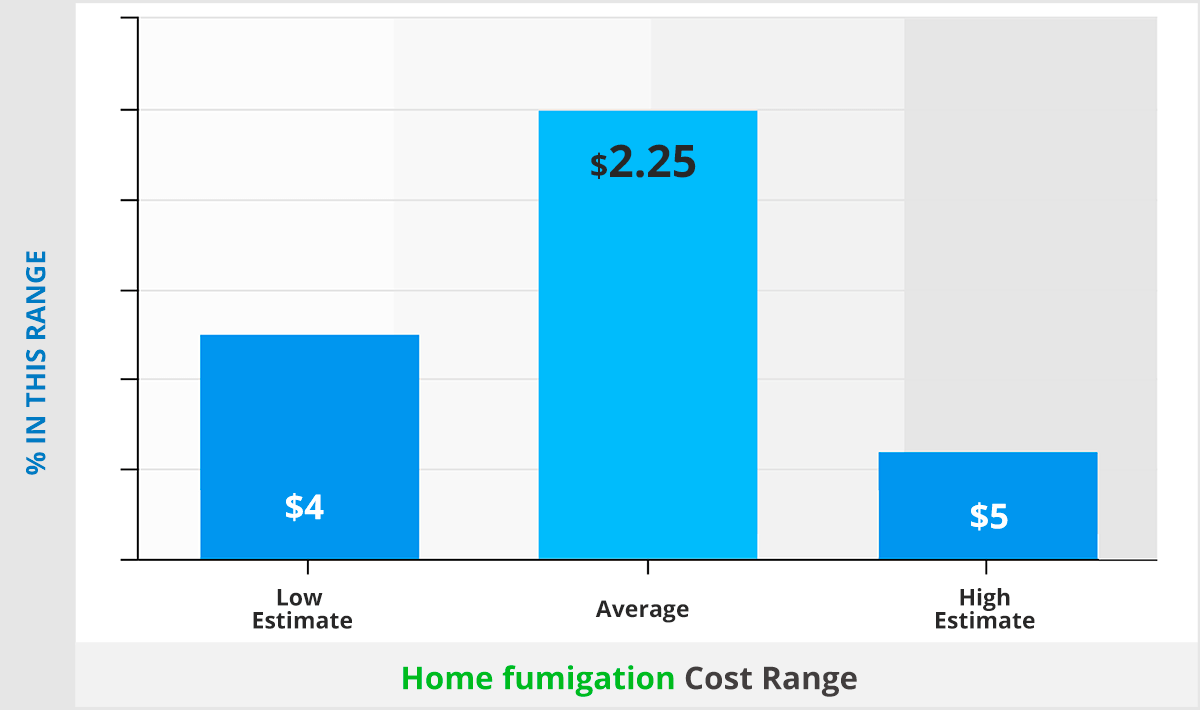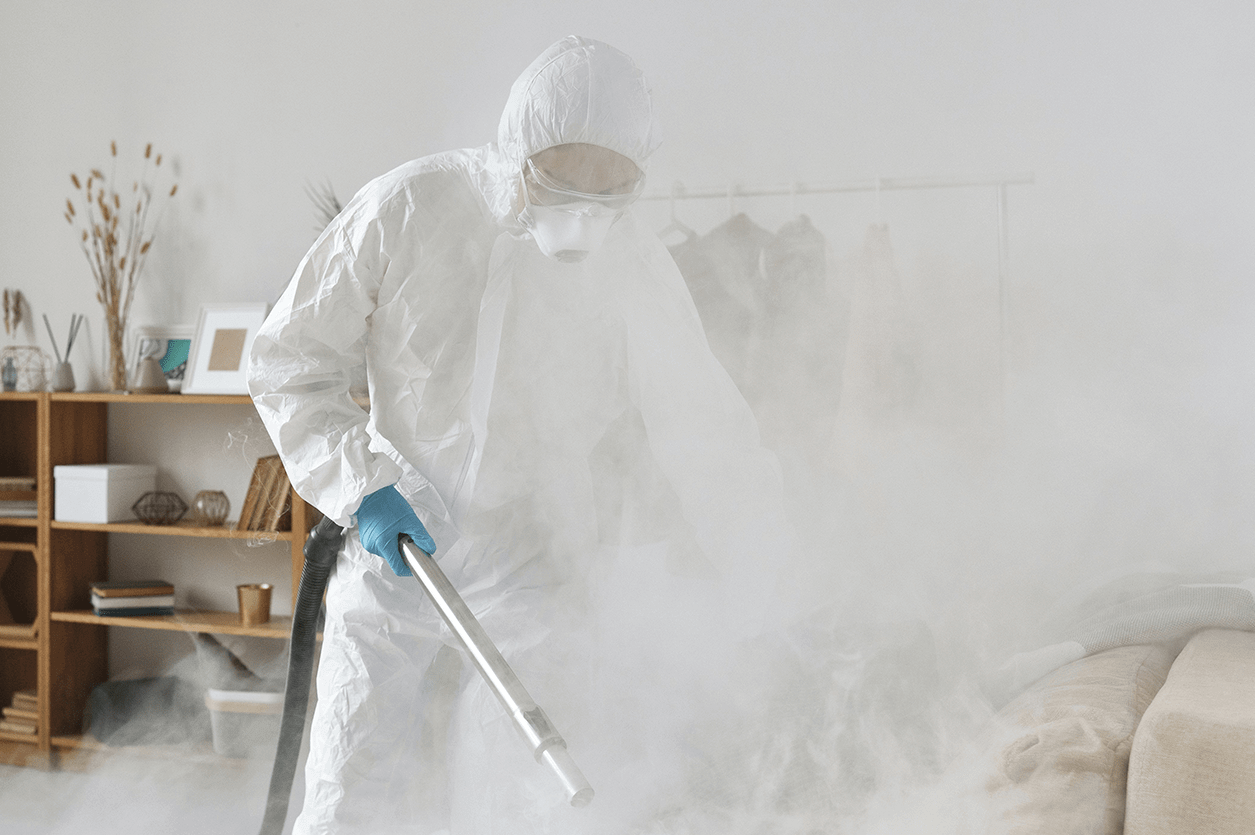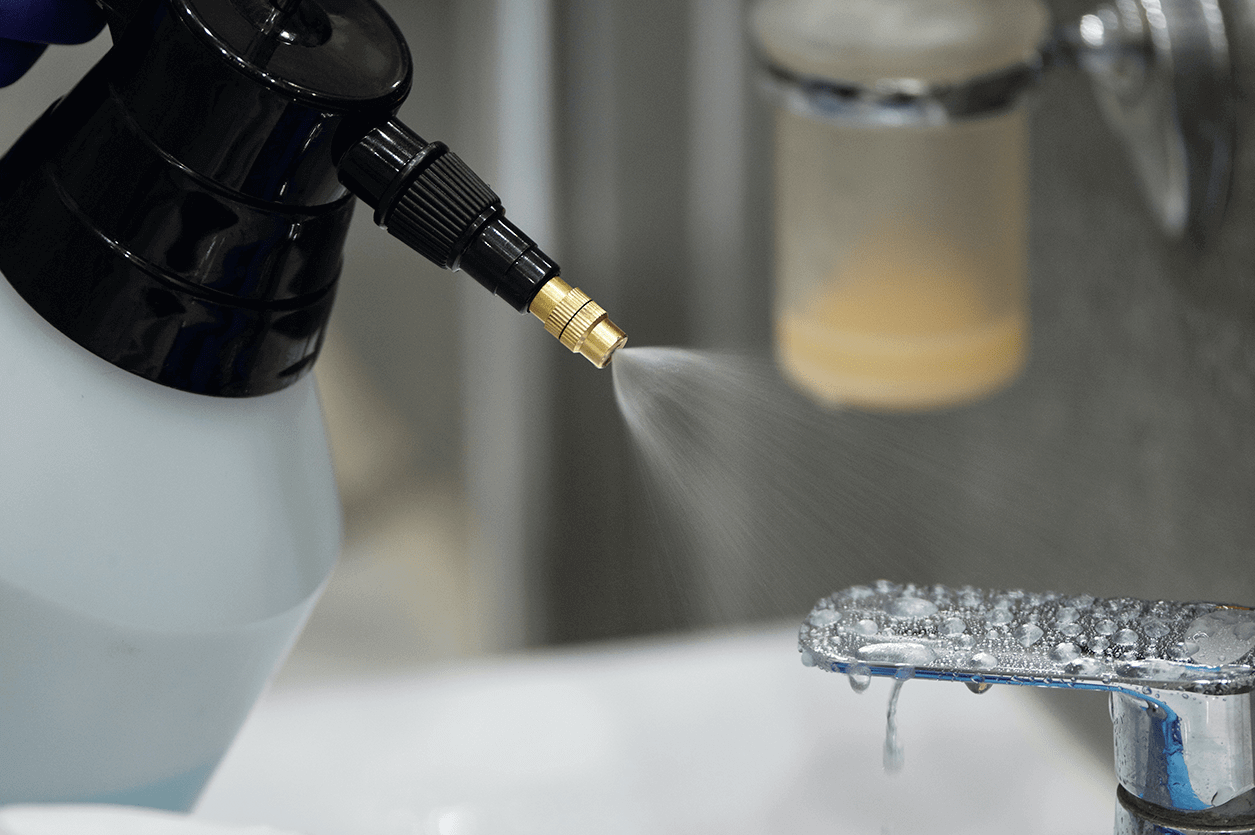The cost of home fumigation, which is also referred to as termite tenting, fluctuates based on the extent of the termite invasion, as well as the dimensions and architecture of the residence.
The home fumigation cost ranges from $1 to $4 per square foot with an average price of $2.5 per square foot with labor costs included. Unlike other pest control methods which are priced per linear foot, fumigation is priced per square foot because it covers the entire house.
Even though fumigation is an expensive and time-consuming process, it is an effective way to exterminate “uninvited guests” from your home plus it is a relatively safe process. In this article, I will explain the costs of home fumigation and the factors that affect the project’s overall cost.
What we cover
ToggleWhat is fumigation?
Fumigation, or tenting, is one of the many pest control methods. This pest control treatment involves realizing pesticides (gaseous fumigants) that fill the space entirely and help you eradicate termites completely.
Fumigants used in households are primarily odorless and will dissipate over time, while chemicals involved in the process require the removal of all

plants, people, and pets from the home. Fumigation is also known as “tenting” because the whole house must be covered entirely by a tent in order to ensure the fumigant works and doesn’t dissipate into the atmosphere “unemployed”.
Properly done fumigation should kill termites completely. For complete removal of the pest and protection from future infestations, it may take a few more fumigation.

Home fumigation costs
The fumigation process costs from $1 to $4 per sq. ft. with the labor costs included.
| Low-end cost | $1 |
|---|---|
| High-end cost | $4 |
| Average cost | $2.5 |
| Size of the house | Cost (labor included) |
| 1,000 sq. ft. | $1,000 - $4,000 |
| 1,500 sq. ft. | $1,500 - $6,000 |
| 2,000 sq. ft. | $2,000 - $8,000 |
| 2,500 sq. ft. | $2,500 - $10,000 |
Factors affecting the fumigation cost
There are several cost factors that will determine the termite fumigation cost. They are listed and explained below:
The size of the house
This is the main factor in calculating the final cost of the fumigation process. Additionally, if your house includes areas like crawl spaces or attics the price will increase. You must know that you cannot partially fumigate only infested areas, you must take into account the size of the entire house.
Type and severity of the termite infestation
If you have decided on fumigation, it means that you already have a serious problem and severe infestation. Before the process starts, consult an expert to conduct a termite inspection to determine the exact type and severity of infestation before proceeding, because fumigation involves realizing gaseous chemicals throughout the house.
House structure
Structurally complex houses definitely increase the overall cost of fumigation. There is a possibility fumigation treatment to affect the physical structure of your house, so preventative measures must be taken in order to reduce risk as much as possible. This is another reason why fumigation always must be conducted by professional termite control companies.
Method and frequency
The type of chemicals used will significantly affect the overall cost of the fumigation. Repeated fumigations if needed may double or even triple the initial bill.
Repetition of the process is most often connected with the professional experience of your pest control provider. Because of this always hire an experienced pest control company/agent and don’t try to save money here since fumigation is a precise process, so look for the best possible company to oversee it.
Want a shortcut?
The fastest and easiest way to get 3 free estimates from the most affordable professional services near you is by using this FREE service.
GoTreeQuotes.com helps to match you with the three local pest control services that have been voted as the best by previous users. Follow the steps below:
- Scroll up to the top of the page and enter your Zip code;
- Fill out the quick form with the details about your pest infestation problem;
- The details about your problem will be forwarded to the closest professionals who will bid on your job at a great price.
When fumigation is needed?
Fumigation’s main purpose is termite extermination and it is recommended for pests such as termites and roaches in situations where the infestation is difficult to access or invisible to the naked eye. Both of the named insects live in large colonies and can easily double or even triple their number if left unattended for too long.
Fumigation is usually a “last method” for treating extreme infestation due to its complexity and intensity. When you notice the problem consult a professional as they can provide an assessment and consultation to determine the type of pest and severity of the infestation, and will recommend to you what pest control methods are available for your problem.
Preparing for fumigation
Pest control companies that will conduct the fumigation process for you will advise you on all the steps you must take in order to prepare the field for fumigation, but it is good to be mentioned here as well:
- Remove all the plants and all living things from your home as well;
- Remove/seal all food, medicine, pet food, etc.
- Arrange to lodge because you will not be able to stay in your home for a few days;
- Turn off all natural gas lines;
- Make a note of all ventilation or exterior access points in your home;
- Prepare spare keys to be given to the pest control company.
These are some general actions that you should take. In consultation with the company you have chosen to complete the work, you will define all the necessary details for successfully preparing your home for the fumigation process.
Alternatives to fumigation
If you are not interested in fumigation or you just want to explore new other options, there are some alternatives to fumigation. Keep in mind that fumigation is the best pest control method for complete termite eradication and extreme infestations without significant damage to the structure of your home and possessions. Here are some alternatives to fumigation:
Liquid treatments
Any method that includes applying liquid chemicals (pesticides) directly onto the infestation is considered liquid treatment. The two most common applications of this method are spot treatments and liquid sprays.
Liquid treatments are effective but require your infestation to be visible and accessible which is not always possible. Also, improper and clumsy handling of the product can cause extreme damage to your possessions and to people and animals. When you use or prepare liquid treatments you must consider risks such as electrical shocks, fire, chemical burns, etc.

Heat treatment
As the name suggests, this treatment includes using extremely high temperatures to exterminate the pests and it is the only effective alternative to fumigation that does not use pesticides. During heat treatment, the target room or space is slowly heated to a temperature fatal to the target pests.
While some treatments are DIY projects, heat treatments must be carried out only by professionals because they require specialized equipment and plenty of preparation in order to ensure that all your possessions, as well as your home, do not suffer heat damage.
Dust treatments
These treatments include dry powders (such as desiccants) with toxic active ingredients and their advantage is that the dust can be dispersed in hard-to-reach areas that are affected by the infestation.
The dust treatments have numerous effects on the target pests, including poisoning or abrading exoskeletons so the pests dehydrate. Dust guarantees long-term pest control as long as it does not get wet or disturbed.
Boric acid and diatomaceous earth are the most common dust treatments for households. Keep in mind that dust treatments should not be used in exposed or highly trafficked areas and precautions must be taken so dust is not inhaled.
Baiting treatments
This treatment is commonly used for larger animals like rats, but it can be used for insects as well. The bait type and exact process depend on the particular pest and the local environmental conditions.
In general, baiting involves mixing pesticides with attractive food materials and leaving them near the infestation and where pests regularly pass. You can find pre-prepared bait treatments. This method of pest control often carries less risk compared to other treatments but you must ensure that “innocent” animals, such as a pet, or a child do not ingest the bait. Baiting treatments work slowly so the best results you will have if you deal with a small or temporary infestation. I must mention that these types of treatments cannot guarantee a full eradication of the infestation.
Home fumigation pros & cons
Like anything else fumigation comes with cons and pros. The biggest advantage of fumigation is effectiveness. Using strong chemicals during the whole process leaves a residue that stops termites from coming back to your house even the termites that are hiding in wooden structures throughout your home as the chemicals spread across all surfaces.
On the other hand, the usage of strong and deadly chemicals characterizes this process as hostile to the environment, which is one of his biggest drawbacks. Actually, fumigation is outlawed in areas close to nature preserves and natural bodies of water. Also, the duration of the process is considered a con. You will have to be out of your house for a few days while the chemicals disperse.
Termite fumigation inspection
Usually, termite fumigation companies will give you a price with the termite inspections included. Pre-fumigation and inspection after fumigation must be conducted.
Pre-fumigation inspection
Before anything else, the pre-fumigation inspection must be conducted by your exterminator. During the termite inspection of your property exterminator will look for signs of termites and other pests to identify both drywood and subterranean termites. The exterminator will look for obvious damages to your home and property and this is the crucial process because it will determine the best treatment plan and you can tell how severe is the infestation and what to expect at the end.
Post-fumigation inspection
Once fumigation is done, the exterminator must finish the inspection. The final inspection includes a close examination of the wooden floors and furniture for any signs of termites left. Also, you must be sure that it is safe for you and your family to come back to your house. And last but not least your exterminator must recommend ways to protect your home against pests in the future.
Termites fumigation VS other treatments cost
Two more pest control treatments similar to fumigation are available. Let’s make a comparison of the costs.
Termite fumigation VS Spot treatment
Spot treatment is also a trusted option for a termite examination. When it comes to cost, spot treatment is about half more expensive than fumigation from $6 to $8 per square foot. It is more expensive than fumigation because it is usually used for smaller areas and painting and wood replacement may be needed afterward.
| Treatment type | Cost per square foot (labor included) |
|---|---|
| Fumigation | $1 - $4 |
| Spot | $6 - &8 |
Prices are different between these two treatments because they target termites differently. Tenting requires the entire home to be treated to kill any termites inside while spot treatment is a micro treatment that helps control termites in a small area where the insects haven’t spread yet. Even it is spot treatment is more expensive than fumigation, it is more convenient and effective for small infestations.
Termite fumigation VS Tentless Treatment
The upper limits of the price scale between these two treatments differ significantly from each other. Tentless termite treatment costs range from $3 – $16 per linear foot, depending on the type you choose. It is very important to mention that tentless treatments are intended for small areas rather than the entire house.
We already mentioned that tent fumigation is a great option for large and severe infestations and works perfectly for drywood termites and dampwood termites. On the other hand, termite bait or barrier treatment (two types of tentless treatments) is recommended for subterranean termite infestations.
| Treatment type | Cost (labor included) |
|---|---|
| Tent fumigation | $1 - $4 per square foot |
| Tentless fumigation | $3 - $16 per linear foot |
Additional costs and considerations
How much termite tenting costs is determined by some considerations and additional costs too.
Other effects
Termite tenting will eradicate other pests, such as bed bugs, fleas, and ticks. Strong chemicals used during tenting will kill on the way other pests in your home that you may not even know are in your home. This is another positive side of this process.
Re-infestation
Even though termite fumigation is a significantly efficient process there is a chance for re-infestation. The key factor for possible re-infestation is the termite activity in your area. Depending on the infestation, termites may reappear after six months or a year after the last chemical treatment. Of course for repeated treatment, you will have to pay again.
Accommodation
When doing fumigation you should factor the cost to rent into the overall cost of the project unless you can stay with your relatives or friends for free. Dislocation of your family is a must during fumigation for everyone’s safety.
Prevention
No one can guarantee you 100% that termites won’t come back. Combining termite tenting with a barrier treatment will provide you best chances for success. This combination will eradicate any existing termites and create a strong line of defense against future infestation.
FAQ's
Fumigations carried out by certified pest control companies combined with the full cooperation of the owner are safe. All the pesticides and safety procedures involved are regulated by state and federal guidelines. Also, the pest control company must notify the local fire department during fumigation.
It is hard to give a straightforward question to this question. The complete fumigation process involves preparation of your home, tenting, fumigation itself, and waiting for re-entry clearance. The fumigation process lasts from one day to a week depending on your house’s size and structural complexity.
All the chemicals used during a process need to be dispersed so you and your family are not at risk. Generally speaking, after four or five days you can safely return to your home.
You must remove all plants and animals from your home before fumigation. If you have unsealed food or medication double bag them in nylon polymer bags or take them with you.
Pest control treatments are considered preventable so insurers usually do not cover them.
This is a must. This is the first thing you need to do after fumigation. It will help you get rid of any chemicals before you enter your home again and clean all dead pests lying around the house.












